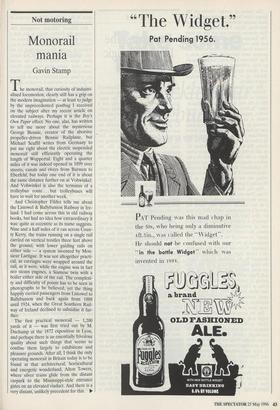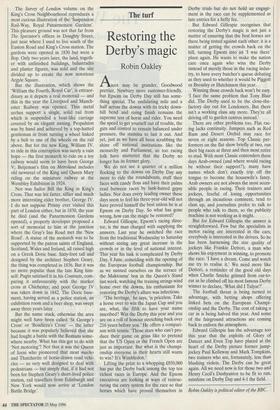Not motoring
Monorail mania
Gavin Stamp
The monorail, that curiosity of industri- alised locomotion, clearly still has a grip on the modern imagination — at least to judge by the unprecedented postbag I received on the subject after my recent article on elevated railways. Perhaps it is the Boy's Own Paper effect. No one, alas, has written to tell me more about the mysterious George Bennie, creator of the abortive propeller-driven Bennie Railplane, but Michael Scuffil writes from Germany to put me right about the electric suspended monorail still efficiently operating the length of Wuppertal. Eight and a quarter miles of it was indeed opened in 1899 over streets, canals and rivers from Barmen to Eberfeld, but today one end of it is about the same distance further on at Vohwinkel. And Vohwinkel is also the terminus of a trolleybus route .. . but trolleybuses will have to wait for another week.
And Christopher Fildes tells me about the Listowel & Ballybunion Railway in Ire- land. I had come across this in old railway books, but had no idea how extraordinary it was: quite as eccentric as its name suggests. Nine and a half miles of it ran across Coun- ty Kerry, the trains running on a single rail carried on vertical trestles three feet above the ground, with lower guiding rails on either side — a system invented by Mon- sieur Lartigue. It was not altogether practi- cal, as carriages were wrapped around the rail, as it were, while the engine was in fact two steam engines, a Siamese twin with a boiler either side of the rail. The complexi- ty and difficulty of points has to be seen in photographs to be believed, yet the thing happily carried passengers from Listowel to Ballybunion and back again from 1888 until 1924, when the Great Southern Rail- way of Ireland declined to subsidise it fur- ther.
The first practical monorail — 1,200 yards of it — was first tried out by M. Duchamp at the 1872 exposition in Lyon, and perhaps there is an essentially frivolous quality about such things that seems to confine them largely to exhibitions and pleasure grounds. After all, I think the only operating monorail in Britain today is to be found at that architectural, horticultural and energetic wonderland, Alton Towers, where silver trains glide from the distant carpark to the Mississippi-style entrance gates on an elevated viaduct. And there is a very distant, unlikely precedent for this. 10. The Survey of London volume on the King's Cross Neighbourhood reproduces a most curious illustration of the 'Suspension Rail-Way, Royal Panarrnonion Gardens'. This pleasure ground was not that far from The Spectator's offices in Doughty Street, just near where I used to live south of the Euston Road and King's Cross station. The gardens were opened in 1830 but were a flop. Only two years later, the land, togeth- er with unfinished buildings, balustrades and plaster figures, was sold and the site divided up to create the now notorious Argyle Square.
But the illustration, which shows the William the Fourth, Royal Car', is extraor- dinary as it depicts a real monorail — and this in the year the Liverpool and Manch- ester Railway was opened. Thin metal arches support a single, solid rail from which is suspended a boat-like carriage covered by an elegant awning. Propulsion was by hand and achieved by a top-hatted gentleman in front turning a wheel linked by a belt to one of the wheels on the rail above. But for the new King, William IV, to ride in this contraption was surely a vain hope — the first monarch to ride on a toy railway would seem to have been George V; Betjeman's film on Metroland includes old newsreel of the King and Queen Mary riding on the miniature railway at the Wembley Exhibition in 1924.
Nor was Sailor Bill the King in King's Cross. That was his fatter, sillier and much more interesting elder brother, George IV. I do not suppose Prinny ever visited this part of London either, but in 1830, the year he died (and the Panarmonion Gardens opened), a property developer proposed a sort of memorial to him at the junction where the Gray's Inn Road met the 'New Road'. A statue of the monarch was to be supported by the patron saints of England, Scotland, Wales and Ireland, all raised high on a Greek Doric base. Sixty-foot tall and designed by the architect Stephen Geary, the thing was completed in 1836. But it was no more popular than the late King him- self: Pugin satirised it in his Contrasts, com- paring it unfavourably with the market cross at Chichester, and poor George IV was taken down in 1842. The Doric base- ment, having served as a police station, an exhibition room and a beer shop, was swept away three years later.
But the name stuck, otherwise the area might well have been called 'St George's Cross' or 'Boadicea's Cross' — the latter because it was popularly believed that she had fought a battle with the Romans some- where nearby. What has this got to do with 'Not motoring'? Not that it was the Queen of Iceni who pioneered that most macho and Thatcherite of horse-drawn road vehi- cles — so very well designed to deal with pedestrians — but simply that, if it had not been for Stephen Geary's short-lived police station, rail travellers from Edinburgh and New York would now arrive at 'London Battle Bridge'.



























































 Previous page
Previous page